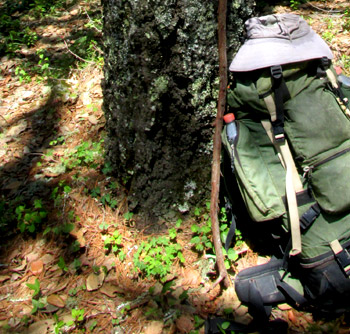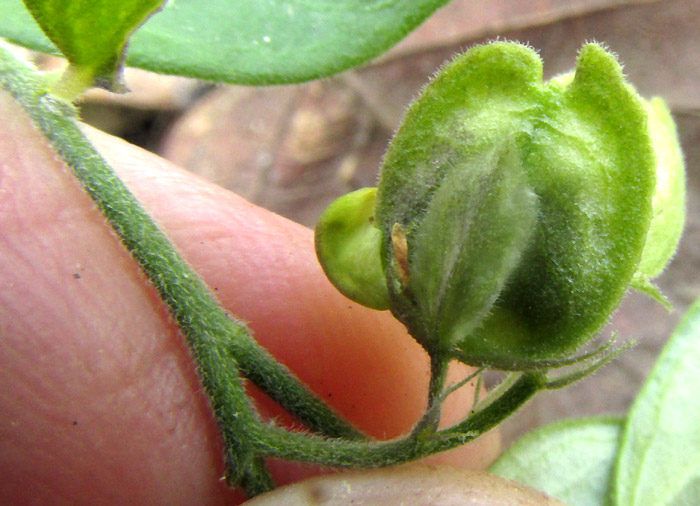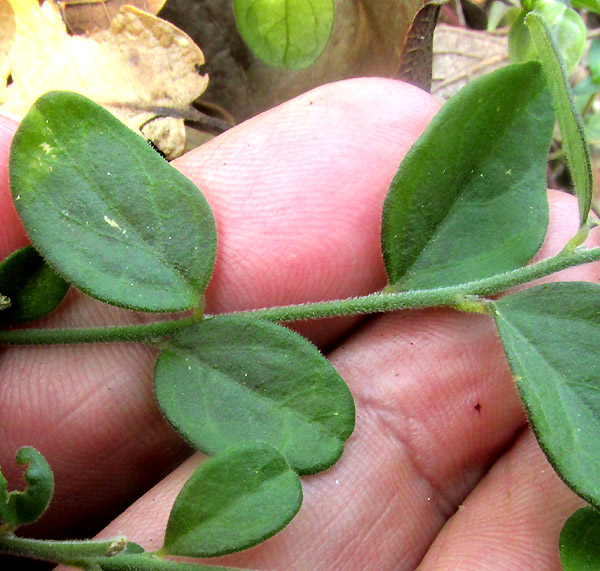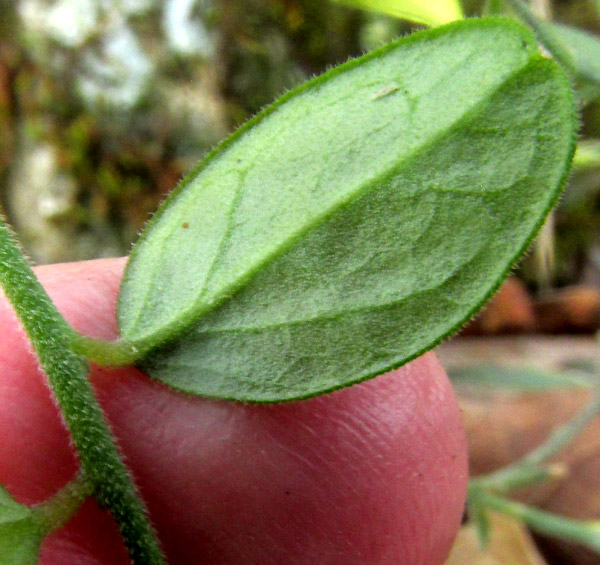Excerpts from Jim Conrad's
Naturalist Newsletter
Entry dated November 9, 2023, from notes taken near Cascadas de La Piedad waterfall 3kms NW of the community of San Pablo, municipality of Almeaco de Bonfil; oak forest atop bedrock of thick layers of compacted volcanic ash, or tuff; N20.1024°, W100.0019°, elevation 2360 meters (7750ft); extreme southern Querétaro state, MÉXICO
HEBECARPA MYRTILLOIDES


Atop a ridge covered with a somewhat open oak forest, a small population of the above herb clustered around the trunk of a Quercus obtusata, as shown at the right. The much-branched herbs had been snipped back by herbivores and looked a bit ragged. They would have remained ignored except that one plant bore a pea-size, yellowish-green fruit, in the top picture barely visible a little above and to the left of my index finger's tip. Up close, the fruit was unusual:

The oval, capsular-type fruit was curiously notched or two-eared at its top. If you look closely you can see a thin, dark green line descending from the trough of the notch, over the flat surface's face, to the capsule's bottom. That's a suture or seam where later the mature capsule later will split open; it's the fruit's "line of dehiscence." A darkened bulge on each side of the line of dehiscence suggests that the fruit contains two seeds. Having lines of dehiscence crossing the capsule's flat faces, not along the sharp edges, was unusual.
Arising atop the fruit's stalk, or pedicel, two small, leaf-like green items, sepals, of very different size and shape are visible. To the left of the fruit and behind it, a curved, green object emerges; this looks like the front end of an immature, bilaterally symmetrical flower not noticed during the picture taking. In fact, the fruit itself its bilaterally symmetrical, along with the different-size sepals. Everything is covered with short, straight hairs, with stem hairs strongly directed forward, keeping close to the plant surface.
The above features may seem too obscure to bother describing, but all were important during the identification process, especially because we have no flowers. Flower structure usually is the main indicator of what kind of plant is being dealt with.

Simple leaves with no teeth, lobes or crenulations along the margins grew singly from the stems, which tended to grow atop the leaf litter. The blades' tips were rounded to slightly notched.

Leaf undersurfaces were paler than the surfaces, because of the dense covering of short hairs.
A herbaceous plant lying close to the ground bearing small capsular fruits presumably preceded by bilaterally symmetrical flowers, and bearing one simple leaf per stem node, suggested to me either one of the few genera of the Bean Family capable of developing simple leaves, or the much smaller but closely related Milkwort Family. Since our plant produced no stipules at its petioles' bases -- usually observed on members of the Bean Family, first I checked into the Milkwort Family, the Polygalaceae.
The Milkwort Family is not well documented in this part of Mexico, and in recent years there's been a great deal of shuffling the taxa about. With regard to our plant beside the oak tree, identification involved looking into a newly resurrected Milkwort Family genus I didn't know existed, the genus Hebecarpa; Hebecarpa species occur only from the southern US south into western South America. The species are known by no English names.
Among Mexican species of Hebecarpa, our plant's broadly oval leaves with bluntly rounded tips makes it fairly distinctive; most Mexican species' leaves are considerably narrower and the blades' tips more sharply pointed. Seeing the leaves and fruits, we don't need the species' pretty, yellow blossoms for identification. Our plant is HEBECARPA MYRTILLOIDES, earlier known as Polygala myrtilloides.
Hebecarpa myrtilloides is endemic only to the uplands of central Mexico from southern Durango state south to Puebla state. Judging from cited collections, it seems to be uncommonly documented, though perhaps not particularly rare.
No further information can be found about the species' habitat preferences or its uses. It's just an obscure little plant quietly contributing to the Earth's biosphere in its own generous manner, whether it's recognized by humans or not.